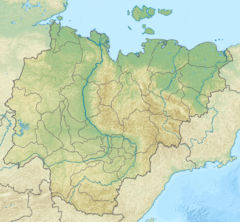Vilyuy
| Vilyuy | |
|---|---|
 Rapids on the Vilyuy in Central Sakha | |
Location of the mouth in Yakutia, Russia | |
| Native name | Russian: Вилю́й; Yakut: Бүлүү Error {{native name checker}}: list markup expected for multiple names (help) |
| Location | |
| Country | Russia |
| Federal subjects | Krasnoyarsk Krai, Yakutia |
| Physical characteristics | |
| Source | |
| • location | Vilyuy Plateau |
| • coordinates | 65°57′46″N 103°30′47″E / 65.96278°N 103.51306°E |
| • elevation | 520 m (1,710 ft) |
| Mouth | Lena |
• coordinates | 64°22′38″N 126°24′54″E / 64.37722°N 126.41500°E |
• elevation | 55 m (180 ft) |
| Length | 2,650 km (1,650 mi) |
| Basin size | 454,000 km2 (175,000 sq mi) |
| Discharge | |
| • average | 1,700 m3/s (60,000 cu ft/s) |
| Basin features | |
| Progression | Lena→ Laptev Sea |

The Vilyuy (Russian: Вилю́й, IPA: [vʲɪˈlʲʉj]; Yakut: Бүлүү, Bülüü, IPA: [bylyː])[citation needed] is a river in Russia, the longest tributary of the Lena. About 2,650 kilometres (1,650 mi) long, it flows mostly within the Sakha Republic. Its basin covers about 454,000 square kilometres (175,000 sq mi).[1]
History
The river is first mentioned in the 17th century in connection with the Russian conquest of Siberia. In 1634, Russian Cossacks, headed by Voin Shakhov, established a winter settlement at the confluence of the rivers Vilyuy and Tyukyan. This settlement served as the administrative center of the area for several decades, after which it was moved to the Yolyonnyokh area 45 kilometers (28 mi) down by the Vilyuy, where the ostrog (fortified settlement) of Olensk (now Vilyuysk) was founded in 1773.[citation needed]
In the 1950s diamond deposits were discovered in the area, about 700 kilometres (430 mi) from its mouth. This led to the construction of the Mir Mine, together with access roads and an airport, and the Vilyuy Dam complex to generate power needed for the diamond concentrators.[2]
Course
The Vilyuy has its sources in the Vilyuy Plateau, part of the Central Siberian Plateau, in the Evenkiysky District (Krasnoyarsk Krai]]) and, flowing east, soon enters Sakha. It turns towards the south and southeast in the Central Yakutian Lowland, then back towards the east, and finally enters the Lena about 350 kilometres (220 mi) downstream of Yakutsk, near Sangar. The Ust-Vilyuy Range rises above the facing bank of the Lena, opposite the mouth of the Vilyuy.[3]
To the west of the Vilyuy and Chona is the Nizhnyaya Tunguska basin. The Vilyuy basin is sparsely populated. Small settlements along the river include Vilyuysk, Verkhnevilyuysk, Suntar, and Nyurba.
The main tributaries of the Vilyuy are the Ulakhan-Vava, Chirkuo, Chona, Chybyda, Ulakhan-Botuobuya, Ochchuguy-Botuobuya, Tangnary and Bappagay on the right; and the Akhtaranda, Ygyatta, Markha, Tyukyan and Tyung on the left.[2]
 |
 |
See also
- List of rivers of Russia
- Tukulan, sand dunes
References
- ^ "Река ВИЛЮЙ in the State Water Register of Russia". textual.ru (in Russian).
- ^ a b A. Gavrilov, Вилюй in: Great Russian Encyclopedia.
- ^ Хребет Усть-Вилюйский - Wikimapia
External links
 Media related to Vilyuy River at Wikimedia Commons
Media related to Vilyuy River at Wikimedia Commons- Encyclopædia Britannica

